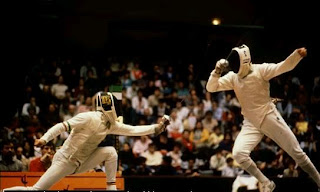 Fencing, art of attack and defense with a sword or similar weapon. Modern fencing is a recreational and competitive sport.
Fencing, art of attack and defense with a sword or similar weapon. Modern fencing is a recreational and competitive sport.Fencing Weapons :
 Three weapons are used in the modern sport of fencing: foil, épée, and saber. The blades of these weapons are made of tempered steel, and each has a maximum blade length of about 89 cm (35 in); the maximum weight of foil and saber is about 500 g (about 17.6 oz), that of épée about 770 g (about 27.2 oz).
Three weapons are used in the modern sport of fencing: foil, épée, and saber. The blades of these weapons are made of tempered steel, and each has a maximum blade length of about 89 cm (35 in); the maximum weight of foil and saber is about 500 g (about 17.6 oz), that of épée about 770 g (about 27.2 oz).Attack & Defence :
Certain fundamental techniques are common to all three weapons. Attack and defence are initiated from the basic on-guard position, a crouch assumed with both knees flexed, the rear arm crooked upwards, and the sword arm partially extended towards the opponent. The lunge is the basic attacking action, executed by stabbing with the sword arm at the target and thrusting forwards on the front leg. The attack is successful if a touch is scored on the valid target area.A parry is a movement of the blade designed to block an attack. A riposte is the return thrust made immediately following a parry.Bouts are conducted on a strip approximately 1.5 to 2 m (4.9 to 6.6 ft) wide and 14 m (46 ft) long. The first fencer to score five touches wins a bout. In formal competition the weapons are wired and connected to an electrical scoring apparatus, so that a light flashes on the sidelines when a touch is scored.
Competition :
Fencing has been one of the events in the Olympic Games since 1896, and épée fencing is one of the five events in the modern pentathlon. International competitions are sanctioned by the Fédération Internationale d'Escrime (International Federation of Fencing), the world governing body of the sport. A world championship is held annually to determine individual and team champions of each weapon.
Bibliography :
C.L. de Beaumont, Fencing: Ancient Art and Modern Sport, rev. ed. (1978), is a standard textbook. Other works include Michel Alaux, Modern Fencing (1975); Albert Manley, Complete Fencing (1979); and Maxwell R. Garret, Mary Heinecke Poulson, and Steve Sobel, Foil Fencing (1981), which also contains a discussion of legal responsibility.